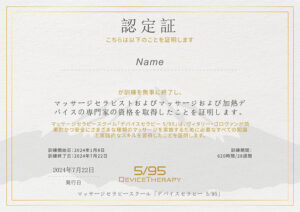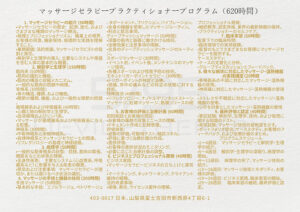Massage Therapy Practitioner Program (600 Hours)
History of Massage Therapy:
- Origins, evolution, and different types of massage therapies.
Ethics and Professionalism:
- Understanding professional boundaries, client consent, confidentiality, and ethical practice.
Scope of Practice:
- Legal aspects, roles, and responsibilities of a massage therapist.
Introduction to Anatomy and Physiology:
- Basic overview of the human body, including major systems and terminology.
Muscular System (50 Hours):
- Identification and functions of muscles.
- Muscular structure and contraction mechanisms.
- Common muscular issues and pathologies.
Skeletal System (30 Hours):
- Bone structure, types, and functions.
- Joint types, functions, and common joint issues.
Circulatory and Respiratory Systems (40 Hours):
- Anatomy and physiology of the heart and lungs.
- Blood circulation and lymphatic system.
- Impact of massage on circulatory and respiratory systems.
Nervous System (30 Hours):
- Central and peripheral nervous systems.
- Autonomic nervous system and its relevance to massage therapy.
- Reflexology basics and nerve pathways.
Common Musculoskeletal Conditions:
- Understanding of conditions like sprains, strains, arthritis, and more.
Systemic Conditions:
- Overview of diseases affecting major systems (cardiovascular, respiratory, etc.).
Contraindications and Precautions:
- Identifying when massage therapy is appropriate or should be avoided.
Manual Massage (50 Hours):
- Basic strokes: Effleurage, petrissage, tapotement, friction, vibration.
- Full-body device massage routine.
- Benefits and contraindications.
Deep Tissue Massage (50 Hours):
- Techniques for working with deep layers of muscle and fascia.
- Understanding the therapeutic effects and precautions.
- Full-body deep tissue massage routine.
Sports Massage (30 Hours):
- Pre-event, post-event, and maintenance massage techniques.
- Techniques for different sports and injury prevention.
Moxi Trigger Point Therapy (30 Hours):
- Identifying and treating trigger points.
- Techniques for specific conditions like headaches, back pain, etc.
Specialized Modalities (40 Hours):
- Introduction to reflexology, NanoTourmaline hot stone massage, prenatal massage, and myofascial release.
Initial Consultation and Client Intake:
- Gathering client history and understanding their needs.
- Documentation and record-keeping.
Assessment Techniques:
- Postural assessment, range of motion testing, palpation skills.
- Creating a treatment plan based on assessment.
Progress Evaluation:
- Monitoring client progress.
- Adjusting treatment plans as needed.
Business Practices:
- Starting and running a massage therapy business.
- Marketing, networking, and client retention strategies.
Legal Considerations:
- Understanding insurance, liability, and licensing requirements.
Professional Development:
- Continuing education, certifications, and staying current in the field.
- Self-care for practitioners.
Supervised Clinical Hours:
- Hands-on experience in a clinical setting.
- Providing massage therapy to a variety of clients under supervision.
Case Studies:
- Documenting and analyzing cases.
- Group discussions and feedback.
- Use of massage and heating devices for musculoskeletal system problems.
- Use of massage and heating devices for neuralgia.
- Use of massage and heating devices for stress and insomnia.
- Use of massage and heating devices to target biologically active points.
- Written Examination: Testing knowledge of anatomy, physiology, techniques, and ethics.
- Practical Examination: Demonstrating proficiency in massage techniques.
- Portfolio Submission: Compilation of case studies, client feedback, and treatment plans.
Program Schedule
- Weeks 1-4: Introduction to Massage Therapy and Anatomy & Physiology.
- Weeks 5-8: In-depth Anatomy & Physiology, start of Pathology.
- Weeks 9-12: Completion of Pathology, Introduction to Massage Techniques.
- Weeks 13-18: Massage Techniques and Modalities, Client Assessment.
- Weeks 19-24: Business Practices, start of Clinical Practice.
- Weeks 25-28: Continuation of Clinical Practice, Final Assessments, and Certification.
Materials and Resources
- Textbooks on anatomy, physiology, and massage therapy techniques.
- Access to massage tables, oils, and other equipment.
- Anatomy charts, models, and pathology resources.
- Journals and online resources for continued learning.
This program is designed to provide a comprehensive education in massage therapy, preparing students for professional practice with a solid foundation in both theory and hands-on skills.

